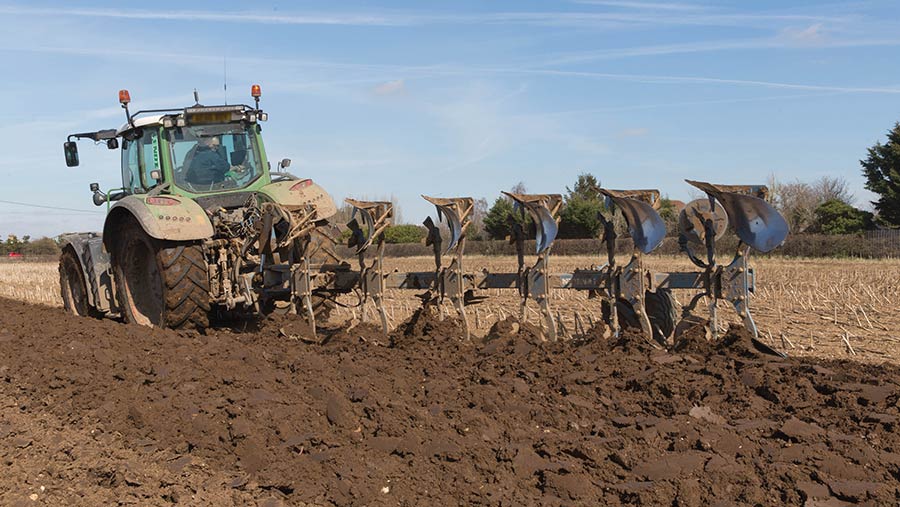Pointers on rescuing waterlogged soils for spring barley
 © Tim Scrivener
© Tim Scrivener The UK spring barley area is predicted to rise 13% this season, and growers are advised to adapt cultivation and drilling methods to resurrect waterlogged soils.
Following the wet winter conditions, which prevented establishment of 25-30% of the UK’s winter crops, attention is turning to successful spring barley establishment that builds yield and quality.
For farmers who rigidly stick to a low soil disturbance system, this could mean adding deeper cultivations or ploughing to help dry soils ahead of drilling.
See also: Advice on farm-saved spring crop seed as storms end drilling
“Weather impacts and establishment conditions are particularly significant for spring barley.
“This is because the crop’s shorter growing period restricts its ability to compensate from suboptimal establishment, compared with winter crops,” explains Rob Jackson, barley technical expert at breeder and agrochemical firm Syngenta.
Cultivation trial
Successful spring barley establishment is often determined by suitable seed-bed moisture and sufficient tilth at drilling.
Where seed coverage is suboptimal, plant counts, establishment and final yield can be affected.
A three-year spring barley cultivation trial carried out by Syngenta investigated the effect of different cultivations on crop establishment.
The following establishment methods were put to the test from 2021-23:
- Plough-based system
- Deep non-inversion (15-20cm)
- Shallow non-inversion(5cm)
- No-till.
In a situation where the drilling method used after no-till was not able to achieve sufficient slot closure over the seed, the low- disturbance approach had negative effects on both crop establishment and yield.
However, ploughing delivered improved establishment and yield as a result of better soil coverage and seed-to-soil contact.
Conversely, in a dry year with limited soil moisture, deep cultivations that moved the most soil and caused the highest moisture loss produced the lowest establishment and yield.
Rob notes the importance of understanding local soil types and advises fields to be monitored individually.
“The ability to be flexible in the establishment system is important in many seasons,” he says.
He talks us through the trial.
2021 A disc drill was used to establish plots across the three cultivation methods. It was difficult to achieve good slot closure in the no-till situation, so seed coverage was insufficient.
Establishment was compromised and, ultimately, it had a negative effect on yield.
The plough-based system created the best seed-bed at drilling, which led to higher plant establishment and overall better yield.
2022 There was very little soil moisture at drilling. The no-till plots had the highest plant counts because there was little soil disturbance, so moisture was retained.
Deep non-inversion was the most intensive cultivation, moving the most amount of soil, and therefore had the highest moisture loss.
This resulted in the lowest establishment, which followed through to lower yield.
2023 Drilling was delayed until mid-April due to the very wet conditions in March. Establishment and subsequent plant growth across all the systems were poor, resulting in low, uneconomic yields.
There was no clear benefit of any cultivation method.
Cover crop destruction date
Belinda Bailey, sustainability manager at Syngenta, says in a wet spring an earlier cover crop destruction date can be beneficial to allow the soil surface to dry.
“By killing off covers earlier you can expose the soil to the sun and wind to help the surface dry and warm up, which is a benefit on heavy land.”
She adds: “Heavy land can be challenging for direct drilling, particularly in wet soil conditions, so ploughing may help dry soils.
“However, if we’re going into a dry spell this spring, particularly on lighter soils, direct drilling may be more preferable and, in this case, later cover crop destruction can be used to support moisture retention during dry periods.”
Nitrogen spring barley trial
Syngenta conducted further trials examining the effect of different nitrogen fertiliser types on malting barley yields and quality.
The trials tested nitrogen rates of 0-200kg/ha on a crop of Laureate malting barley using a range of fertiliser types: ammonium nitrate and urea with and without nitrification and urease inhibitors.
Carbon emissions analysis was undertaken using the Cool Farm Tool. Results revealed:
- Increasing N rate boosted yield, although the level of yield response is reduced, and can plateau above 100kg N/ha
- Increasing N rate directly correlated with increased grain N content
- Nitrogen rate had a bigger effect on carbon emissions than nitrogen type
- There was no consistent pattern across the three-year trial that one source of N is better for yield performance or grain N percentage.
Nitrification inhibitors cut carbon footprint
The addition of nitrification inhibitors to urea fertiliser reduced the carbon footprint, when compared with urea alone, reveals Rob Jackson, barley technical expert.
Nitrification inhibitors slow the microbial conversion of ammonium to nitrite and nitrite to nitrate carried out by populations of nitrosomonas and nitrobacter.
This reduces the risk of denitrification and leaching, thereby increasing the nitrogen use efficiency of fertilisers by maintaining nitrogen in the ammonium form for longer.
“This reduces the amount of the greenhouse gas nitrous oxide released, subsequently reducing carbon footprint,” says Rob.
This is not the case when applying urease inhibitors, as these products block activity of the soil which, in the presence of water, breaks down urea into the readily volatilised ammonium by the enzyme urease.
“Urease inhibitors reduce the amount of ammonia gas released, therefore reducing the losses of applied nitrogen to the atmosphere.
“However, ammonia is not a greenhouse gas and, therefore, doesn’t directly affect carbon emissions,” explains Rob.

